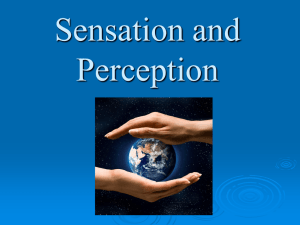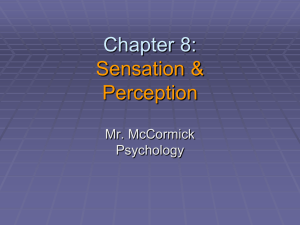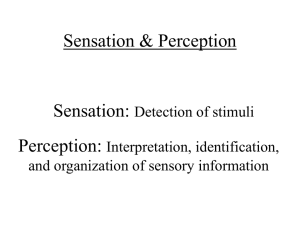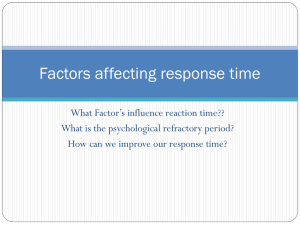File - Old History Website
advertisement
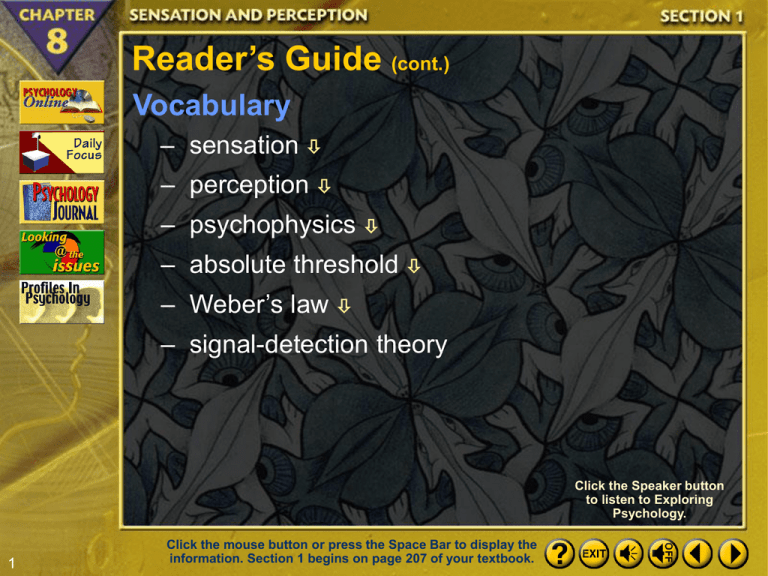
Reader’s Guide (cont.) Vocabulary – sensation – perception – psychophysics – absolute threshold – Weber’s law – signal-detection theory Click the Speaker button to listen to Exploring Psychology. 1 Click the mouse button or press the Space Bar to display the information. Section 1 begins on page 207 of your textbook. • Blindfold Activity – Walk around school with a partner – Hear, Smell, Taste, Touch – How do our other senses overcompensate? 2 What Is Sensation? • The world is filled with physical changes. • Any aspect of or change in the environment to which an organism responds is called a stimulus. • An alarm, an electric light, and an aching muscle are all stimuli for human beings. 3 Click the mouse button or press the Space Bar to display the information. What Is Sensation? (cont.) • A stimulus can be measured in many physical ways, including its size, duration, intensity, or wavelength. • A sensation occurs anytime a stimulus activates one of your receptors. • The sense organs detect physical changes in energy such as heat, light, sound, and physical pressure. sensation what occurs when a stimulus activates a receptor 4 Click the mouse button or press the Space Bar to display the information. • Sensory Deprivation – This tank allows users to escape gravity – Helps recover from strenuous activity – Too much sensory deprivation can lead to loss of IQ 5 What Is Sensation? (cont.) • A sensation may be combined with other sensations and your past experience to yield a perception. • A perception is the organization of sensory information into meaningful experiences. perception the organization of sensory information into meaningful experiences 6 Click the mouse button or press the Space Bar to display the information. Fraser’s Spiral Fraser’s spiral illustrates the difference between sensation and perception. Our perception of this figure is that of a spiral, but it is actually an illusion. Trace the circle carefully. Your finger will always come back to its starting point. 7 What Is Sensation? (cont.) • What is the relationship between color and wavelength? • How does changing a light’s intensity affect your perception of its brightness? • The psychological study of such questions is called psychophysics. psychophysics the study of the relationships between sensory experiences and the physical stimuli that cause them 8 Click the mouse button or press the Space Bar to display the information. Threshold • How much of a stimulus is needed to notice? • Experiments can detect the absolute threshold– the weakest amount of a stimulus required to produce a sensation. absolute threshold the weakest amount of a stimulus that a person can detect half the time 9 Click the mouse button or press the Space Bar to display the information. The Human Senses 10 Sensory Differences and Ratios • Another type of threshold is the difference threshold. • The difference threshold refers to the minimum amount of difference a person can detect between two stimuli. • A related concept is the just noticeable difference, or JND. difference threshold the smallest change in a physical stimulus that can be detected between two stimuli 11 Sensory Differences and Ratios (cont.) • Weber’s law states that the larger or stronger a stimulus, the larger the change required for a person to notice that anything has happened to it. • By experimenting with variations in sounds, temperatures, pressures, colors, tastes, and smells, psychologists are learning more about how each sense responds to stimulation. Weber’s law the principle that the larger or stronger a stimulus, the larger the change required for an observer to notice a difference 12 Click the mouse button or press the Space Bar to display the information. Sensory Differences and Ratios (cont.) • People who can detect minute changes in sensation are called experts. • Experts who can detect small differences work as food tasters, wine tasters, smell experts, perfume experts, and so on. 13 Click the mouse button or press the Space Bar to display the information. Sensory Adaptation • What happens when you eat a ton of HOT CHEETOS • Senses are most responsive to increases and decreases, and to new events rather than to ongoing, unchanging stimulation. • A good example of this sensory adaptation is the increase in visual sensitivity that you experience after a short time in a darkened movie theater. 14 Click the mouse button or press the Space Bar to display the information. Sensory Adaptation (cont.) • Sensory adaptation allows us to notice differences in sensations and react to the challenges of different or changing stimuli. • This principle is helpful when performing many activities, such as the work of police, security guards, and home inspectors. • These people may notice minute changes and act appropriately. 15 Click the mouse button or press the Space Bar to display the information. The Disappearing Circle Sensation depends on change and contrast in the environment. Hold your hand over one eye and stare at the dot in the middle of the circle on the right. You should have no trouble maintaining the image of the circle. If you do the same with the circle on the left, however the image will fade. The circle reappears only if you close and reopen your eye or you shift your gaze to the X. 16 Signal-Detection Theory • There is no sharp boundary between stimuli that you can perceive and stimuli you cannot perceive. • The signal-detection theory studies the relations between motivation, sensitivity, and decision making in detecting the presence or absence of a stimulus (Green & Swets, 1966). signal-detection theory the study of people’s tendencies to make correct judgments in detecting the presence of stimuli 17 Click the mouse button or press the Space Bar to display the information. Signal-Detection Theory (cont.) • Detection thresholds involve recognizing some stimulus against a background of competing stimuli. • In studying the difficulties faced by radar operators, psychologists have reformulated the concept of absolute threshold to take into account the many factors that affect detection of minimal stimuli. • As a result, signal-detection theory abandons the idea that there is a single true absolute threshold for a stimulus. 18 Click the mouse button or press the Space Bar to display the information. 19 The Stroop Effect Name the color of the squares. 20 The Stroop Effect (cont.) Name the color of the words in the figure below. Why was it more difficult to name the color of the words? 21 Section Assessment Review the Vocabulary What is the difference between sensation and perception? A sensation is the activation of a sensory receptor by a stimulus. A perception is the organization of sensation into meaningful experiences. 22 Click the mouse button or press the Space Bar to display the answer. Section Assessment (cont.) Think Critically Why do you think we do not respond to all stimuli present in our environment? We do not respond to all stimuli present in our environment because our bodies would be overloaded with stimuli. Our bodies would soon be unable to process more sensory information. 23 Click the mouse button or press the Space Bar to display the answer. Section Assessment (cont.) What would happen if you asked a four-year-old child who knew his colors but could not read to complete the Stroop effect activity? What if you tried this experiment with someone who did not speak English? What if you used noncolor words? 24
